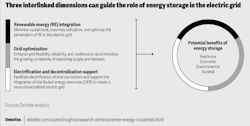Preparing for Net Zero: Harnessing Energy Storage’s Role in Achieving Decarbonization
Energy storage is one important piece in helping power companies achieve their decarbonization goals. Battery-based energy storage capacity installations soared more than 1200% between 2018 and 1H2023, underscoring its significance in the electric power sector. As of October 2023, approximately 120 GW of energy storage projects are in various stages of development.
Several factors are contributing to this growth on the electric grid: Improving economic viability, driven by cost reductions in advanced technologies like lithium-ion batteries, has helped make energy storage a financially attractive solution.
- Changing fuel mix is a key catalyst for energy storage as it helps mitigate the intermittency of wind and solar and can substitute for retiring fossil plants.
- Policy and regulatory support have acknowledged energy storage's pivotal role in enhancing grid stability and resilience. In 2022, the Inflation Reduction Act (IRA) supercharged interest in energy storage. This legislation, combined with prior Federal Energy Regulatory Commission orders and increasing actions taken by states, could help drive a greater shift toward embracing energy storage as a key solution.
- Versatility is at the core of energy storage as it serves numerous grid applications, including peak shaving and frequency regulation. In 2022, while frequency regulation remained the most common energy storage application, 57% of utility-scale US energy storage capacity was used for price arbitrage, up from 17% in 2019.
- Resilience and reliability drive the increased adoption of energy storage, bolstering grid stability and dependability, particularly in regions exposed to extreme weather events.
The evolution of energy storage can be categorized into three distinct eras, shaped by technological advancements and the shift from short-duration to a combination of short- and long-duration energy storage technologies.
- Up to 2021, the Pre-Battery Era marked the early stages of energy storage development, with pumped hydro storage serving as a well-established but geographically constrained solution.
- The Era of Battery Dominance, from 2022 to 2035, is characterized by ongoing battery technology advancements designed to boost capacity, efficiency, and cost-effectiveness.
- The Era of Breakthrough Innovation, from 2036 to 2050, is expected to align with the transition to economy-wide net-zero carbon emissions. It anticipates the emergence of novel storage technologies with higher capacity, seasonal balancing, faster response times, and enhanced sustainability, possibly featuring next-generation batteries and hydrogen-based storage solutions.
These eras delineate the dynamic progression of energy storage, which could be instrumental in shaping a sustainable, carbon-neutral energy future.
Three dimensions guide the role of energy storage on the electric grid:
- Renewable Energy Integration focuses on minimizing curtailment by collocating storage with existing renewable energy plants, maximizing renewable energy utilization by deploying hybrid renewable energy storage systems, and using advanced forecasting to optimize renewable energy utilization. In 2022, California curtailed more than 2,450 GWh of solar and wind output, equivalent to 10% of its monthly power consumption. The issue is not limited to California but is becoming a national challenge, resulting in 8,950 GWh of renewable energy curtailment in 2022.
- Grid Optimization seeks to enhance grid flexibility, reliability, and resilience by replacing carbon-intensive peaker plants with energy storage. Energy storage technology advances can make replacing peaker plants increasingly cost-effective, improving system performance. Integrating behind-the-meter storage with demand response programs and providing ancillary services, as encouraged by FERC orders 841 and 2222 , can be pivotal for optimizing grid management. Furthermore, energy storage can be combined with load management mechanisms, such as time-of-use rates. Deploying storage-centric transmission infrastructure can help address congestion issues and augments grid intelligence.
- Electrification and Decentralization Support aims to facilitate the electrification of end-use sectors and the integration of distributed energy resources (DERs) into a decentralized grid. For industrial electrification, energy storage can help ensure uninterrupted power supply when renewables are not generating. Different storage technologies can be tailored to each sector's unique requirements. By integrating energy storage with electric vehicle (EV) charging infrastructure, fast charging during peak demand periods can be achieved, offering another option in regions where grid infrastructure lags behind EV adoption. Microgrids and community-based solutions with integrated energy storage and renewables can extend reliable and affordable electricity to underserved areas. Finally, energy storage also holds potential in peer-to-peer energy trading platforms, enabling consumers and prosumers to trade electricity directly and enhancing grid stability through energy sharing.
Utilities and power generators can adopt multiple business models for energy storage, such as power purchase agreements for renewable energy-plus-storage installations. Tolling and capacity contracts offer further opportunities. Energy storage as a transmission asset is gaining traction, and Virtual Power Plants (VPPs) aggregate behind-the-meter energy storage with other DERs. Additionally, through subscription-based arrangements, the Microgrid-as-a-Service (MaaS) model can provide commercial and industrial customers with turnkey access to microgrid infrastructure, battery storage, and renewable energy sources.
The California Independent System Operator (CAISO) leads in energy storage deployments. The Electric Reliability Council of Texas (ERCOT) also shows potential due in part to the rapid growth of solar and wind power. Texas's grid faces reliability issues due to high congestion costs, making storage more attractive. Integrating energy storage strategically can allow electric power companies to accelerate renewable energy integration, tackle grid challenges, and enhance energy resilience.
Advanced materials and technology will likely be pivotal in securing energy storage's importance in the future grid. Additionally, supportive policies and dynamic market structures could be instrumental in driving investment, innovation, and widespread adoption of energy storage technologies, helping with their effective integration into power systems.
Marlene Motyka is Deloitte's US Renewable Energy leader and principal, Risk & Financial Advisory, Deloitte Transactions and Business Analytics LLP.
About the Author
Marlene Motyka
Marlene Motyka is Deloitte's US Renewable Energy leader and principal, Risk & Financial Advisory, Deloitte Transactions and Business Analytics LLP.


